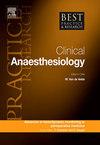Prehabilitation: Stepping beyond exercise in patients with frailty and cancer
IF 2.8
3区 医学
Q1 ANESTHESIOLOGY
Best Practice & Research-Clinical Anaesthesiology
Pub Date : 2025-03-01
DOI:10.1016/j.bpa.2025.03.008
引用次数: 0
Abstract
Cancer is one of the leading causes of morbidity and mortality. In patients who require oncological surgery, frailty is associated with increased risk of perioperative adverse events, which can lead to delay in subsequent oncological care. Additionally, cancer and neoadjuvant therapy both contribute to diminished physiological reserve and increased incidence of frailty. Prehabilitation involves a bundle of preoperative intervention with the goal of improving patients’ physiological reserve and promoting better recovery after surgery. While prehabilitation is frequently associated with the delivery of preoperative physical exercise interventions, there is increasing recognition that a multimodal approach should be employed to optimize outcomes.
Nutritional, educational and psychobehavioral interventions are commonly employed as components of multimodal prehabilitation. There are also other emerging novel interventions, including cognitive prehabilitation. As with all effective perioperative initiatives, effective implementation of prehabilitation often requires a multidisciplinary effort. This review will discuss both the established and the novel prehabilitation interventions, as well as the interaction between prehabilitation and other perioperative pathways.
康复:在虚弱和癌症患者中超越运动
癌症是发病率和死亡率的主要原因之一。在需要肿瘤手术的患者中,虚弱与围手术期不良事件的风险增加有关,这可能导致后续肿瘤治疗的延迟。此外,癌症和新辅助治疗都会减少生理储备,增加虚弱的发生率。预康复包括一系列术前干预,目的是提高患者的生理储备,促进术后更好的恢复。虽然康复通常与术前体育锻炼干预有关,但越来越多的人认识到,应该采用多模式方法来优化结果。营养、教育和心理行为干预通常被用作多模式康复的组成部分。还有其他新兴的新型干预措施,包括认知康复。与所有有效的围手术期举措一样,有效实施康复通常需要多学科的努力。本文将讨论现有的和新的康复干预措施,以及康复与其他围手术期途径之间的相互作用。
本文章由计算机程序翻译,如有差异,请以英文原文为准。
求助全文
约1分钟内获得全文
求助全文
来源期刊

Best Practice & Research-Clinical Anaesthesiology
ANESTHESIOLOGY-
自引率
0.00%
发文量
37
审稿时长
36 days
 求助内容:
求助内容: 应助结果提醒方式:
应助结果提醒方式:


